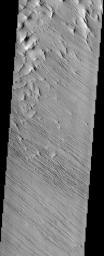
|
Yardangs near Olympus Mons
- Click the image above for a larger view
- Full-Res JPEG (1231 x 3025) (792.9 kB)
- Full-Res TIFF (1231 x 3025) (3.5 MB)
Caption:
In this region of the Olympus Mons aureole, located to the SW of the volcano, the surface has been eroded by the wind into linear landforms called yardangs. These ridges generally point in direction of the prevailing winds that carved them, in this case winds from the southeast. Yardangs typically occur on surfaces that are easily erodable, such as wind-blown dust or volcanic ash. The northeast - southwest trending ridges and valleys in the northwest corner of the image are typical of the Olympus Mons aureole. The varying concentration and shape of the yardangs in this area may be controlled by the motion of winds around these topographic features.
Some crater outlines are visible near the top of this image. The rims of these craters appear to have been stripped away - indicating that the wind erosion is younger than these craters. There are two round knobs in the image, one on the bottom on the right side of the image and another about midway down on the left. These may be inverted craters, formed because the impacts caused materials underneath the crater to become harder to erode than the surrounding materials.
Note: this THEMIS visual image has not been radiometrically nor geometrically calibrated for this preliminary release. An empirical correction has been performed to remove instrumental effects. A linear shift has been applied in the cross-track and down-track direction to approximate spacecraft and planetary motion. Fully calibrated and geometrically projected images will be released through the Planetary Data System in accordance with Project policies at a later time.
Background Info:
NASA's Jet Propulsion Laboratory manages the 2001 Mars Odyssey mission for NASA's Office of Space Science, Washington, D.C. The Thermal Emission Imaging System (THEMIS) was developed by Arizona State University, Tempe, in collaboration with Raytheon Santa Barbara Remote Sensing. The THEMIS investigation is led by Dr. Philip Christensen at Arizona State University. Lockheed Martin Astronautics, Denver, is the prime contractor for the Odyssey project, and developed and built the orbiter. Mission operations are conducted jointly from Lockheed Martin and from JPL, a division of the California Institute of Technology in Pasadena.
Cataloging Keywords:
| Name | Value | Additional Values |
|---|---|---|
| Target | Mars | |
| System | ||
| Target Type | Planet | |
| Mission | 2001 Mars Odyssey | |
| Instrument Host | Mars Odyssey | |
| Host Type | Orbiter | |
| Instrument | Thermal Emission Imaging System (THEMIS) | |
| Detector | ||
| Extra Keywords | Crater, Dust, Grayscale, Impact, Mountain, Thermal, Volcano | |
| Acquisition Date | ||
| Release Date | 2002-12-16 | |
| Date in Caption | ||
| Image Credit | NASA/JPL/Arizona State University | |
| Source | photojournal.jpl.nasa.gov/catalog/PIA04036 | |
| Identifier | PIA04036 | |
